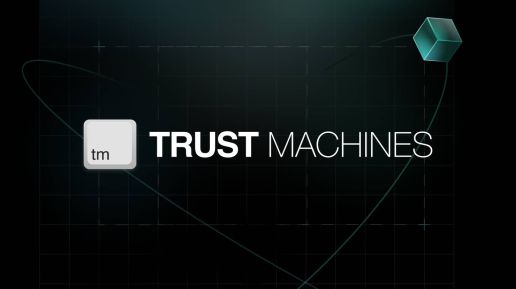One year ago, we launched our company with ambitious goals to unleash the productivity of Bitcoin. In that year, we’ve stayed true to our course – building on Bitcoin.
Our mission is to bring Bitcoin to a billion people and grow its economy. We plan to do so through apps that make the Bitcoin network productive and leverage the blockchain as a settlement layer.
And now, we’re thrilled to share our new and improved website, complete with a Learn Center that, we hope, will serve as your friendly resource for all Bitcoin layers.
We also hope that this new Trust Machines website will give you insight into our vision…all of which will – and can – hinge on Bitcoin.
But First, Why Trust Machines?
First and foremost, Trust Machines is a play on Turing Machines.
In short, by inventing the Turing machine, Alan Turing effectively solved a mathematical problem that stumped the world and brought about the first modern day computers.
Needless to say, this completely changed our world, especially with the invention of the Internet and the World Wide Web.
Decades later (in 2008, to be precise), an anonymous developer named Satoshi Nakamoto invented Bitcoin. Its purpose was to enable the movement and transaction of a form of money – in this case, of a digital currency – without a central entity via a new consensus mechanism. It also popularized concepts such as Proof of Work (PoW).
Essentially, Satoshi’s goal was to bring about a future where not only financial transactions – but other forms of information as well – could be owned and controlled by the very people who are engaging in the exchange. There is no need to trust a central entity.
Moreover, the idea was that these systems and new consensus protocol would bring about more stability, security and accountability.
And that brings us here today.
Just as computers and the Web were technologies that transformed the opportunity for value creation, the idea of trust without centralization has ushered us into a new era of computing.
It’s an era that has given us the ability to build high-stakes businesses with both financial and human interactions unlike what we’ve ever seen before.
In short, just as our co-founder, Muneeb Ali, explains in the first ever blog post that we published, “Satoshi has pushed us into a new era of computing: from Turing Machines to Trust Machines.”
“Just as the internet transformed communication and the Web transformed access, Bitcoin transforms trust. The implications are likely to be profound.”
Our Bitcoin Thesis
We have covered why Satoshi created Bitcoin and what this mysterious, anonymous developer intended it to be.
But as newer digital assets have emerged, many have questioned whether it can truly stand the test of time as the demand for decentralized applications (dApps) and use cases expands.
We’ll make our case here. Let’s begin with a few numbers:
- Bitcoin has a market capitalization of half a trillion dollars
- 4.2 percent of the global population owns Bitcoin
- 46 million Americans own Bitcoin
- We've seen a growth of 3X in Bitcoin monthly active developers from 2018 to now
All of this points to one thing: Bitcoin is, by far, the most popular blockchain, even in the face of newer blockchains and digital assets that have emerged over the past few years. Essentially, the nature of Bitcoin's blockchain has helped it remain top of mind for many people worldwide.
Subsequently, the numbers also indicate the possibility of unlocking a half a trillion dollar economy. Ethereum's market cap, for comparison, currently stands at just under $200 billion.
Sounds exciting, doesn’t it?
There’s just one problem: the blockchain, by design, has always faced a scalability problem.
While Bitcoin inspired the creation of newer, full-featured decentralized distributed networks such as Ethereum and Solana, it also represents the largest untapped market for new kinds of applications built upon trust without centralization.
These apps are made possible via programmatic levers and smart contracts that can execute based on a global ledger and shared state on a blockchain.
But right now, only about 1 percent of Bitcoin is currently deployed into smart contracts. This leaves the other approximately 99 percent as passive, untapped capital.
It’s numbers like these that have contributed to its perception as a cryptocurrency that stores value and nothing else.
Unlike Ethereum, for example, Bitcoin wasn’t designed so that applications could be directly built on its base layer. The base layer is meant for secure, final settlement. This means that the value of BTC isn’t staying inside the base layer anymore.
However, scaling solutions do exist. That’s where our focus on Bitcoin layers comes in.
Our Focus On Layers: Expanding the Bitcoin Blockchain
The current Bitcoin economy is simple.
We have miners, investors, spenders, and traders. But with layers, the Bitcoin flywheel economy can be built for innovative and sustained growth with dApps.
In the past few years, we have seen robust ecosystems and new projects emerge on layer 1s that have fundamentally shifted value creation.
Flywheel economies emerge through increased transaction demand with apps. The key to unlocking that flywheel economy for Bitcoin is using layers and other protocols to create dApps and more.
That, ultimately, enables applications to use the Bitcoin L1 as the base layer upon which applications can settle.
Ultimately, we’re taking a layer agnostic approach with our Trust Machines core brand and suite of products as our core engineers develop the very infrastructure of Bitcoin itself.
All of this, we hope, will allow us to truly unlock the potential of using Bitcoin as the base settlement layer with security and scalability in mind.
Behind the Colors
Our goal is to ensure that our vision of building on Bitcoin is reflected across the board, not only in our content but also in the very design of our website itself.
A huge component of this is the color palette that you see on our new website. As you browse through the website, you’ll be able to identify more and more of the colors that tie into our mission.
More specifically, the green that you see on our new website more generally represents the notion of sound money. Bitcoin is, effectively, sound money, and that’s why we’re building on its layers.
The purple reflects certain Bitcoin networks, most notably Lightning and Stacks, to highlight the work done by the Lightning Network and the Stacks ecosystem.
Other layers and sidechains – like Liquid and RSK – are represented by shades of green that have become reflective of their own brands.
It’s also important to note here that the midnight green also represents some of the biggest innovators in the tech space – such as Apple – who, with their introduction, shook up how people traditionally interacted with technology.
These innovators and disruptors unveiled a whole new set of possibilities for people to improve their lives.
And that’s exactly what we’re trying to do here at Trust Machines with Bitcoin.
Our Blog and Learn Center
Despite the blockchain’s enduring popularity, we’re also aware that for many, the concept of building applications on Bitcoin layers is a foreign one. This is especially true since, as we mentioned earlier, the typical perception of cryptocurrency is that it is primarily a store of value.
But through our Trust Machines blog and our Learn Center, we hope to expand the narrative about not just Bitcoin, but also its place in the world as we transition from Web 2.0 to Web 3.0.
Our blog will be a go-to for people to unpack discussions around trending topics in crypto, blockchain, and Web3. It will also be a central hub for updates from our Trust Machines team.
Our Learn Center will primarily introduce our visitors and readers to Bitcoin’s security and history while also outlining its potential through layers and their different uses. Foundational and evergreen in nature, our Learn Center content will outline layer 2 solutions and blockchain protocols (both old and new) that have each, in their myriad of ways, contributed to the Bitcoin economy by helping us discover the variety of technologies that have emerged on the blockchain.
Among those that we highlight: Lightning, Stacks, Liquid, and RSK.
Some of the use cases that we dive into include various Bitcoin DeFi applications, wallets, NFTs, and DLCs.
We intend for our blog and Learn Center to work in conjunction with one another to fully educate seasoned builders and the crypto curious alike on everything from the Bitcoin community to how we can increase Bitcoin adoption.
Building on Bitcoin with Trust Machines
Our startup has grown to more than 30 people.
This same team dedicates itself to expanding the infrastructure for the Bitcoin blockchain. This includes contributing to the future of everything from transactions on the Bitcoin chain (including faster transactions) to Bitcoin-based information and privacy solutions and extending smart contract functionality (including how to support smart contracts better).
We're also dedicated to building a suite of products that are designed to leverage the full capabilities of the Bitcoin ecosystem.
But most of all, we’re a team that’s dedicated to showing the wider world the possibilities that come with using Bitcoin as a highly secure and decentralized base blockchain layer.
To us, scaling Bitcoin will give us infinite possibilities to impact not just all of blockchain technology, but also give people around the world a focal point that they can use to really rethink how they engage with existing mediums of exchange, along with how they interact with financial and societal institutions.
We want people to reexamine what has become part of their everyday lives, from fiat currencies to what payment channels they use, from how they communicate with one another to what intermediaries they use on a daily basis between themselves and other entities.
We’re excited to show the world what we envision for the future.


